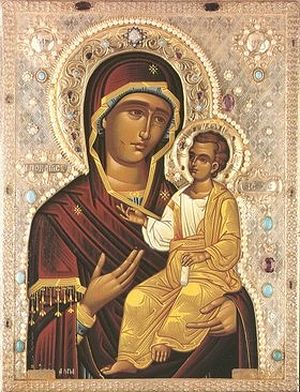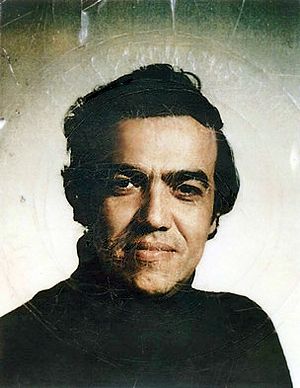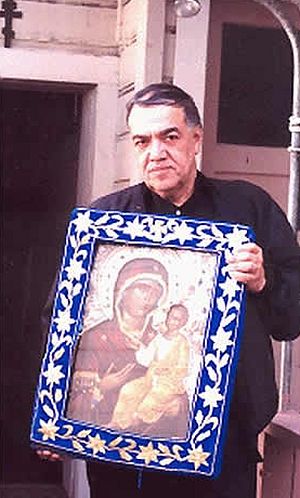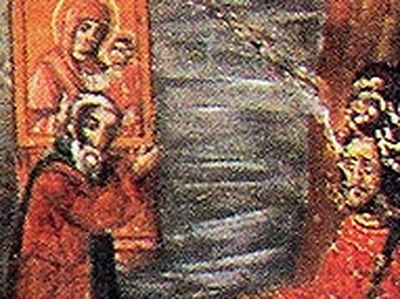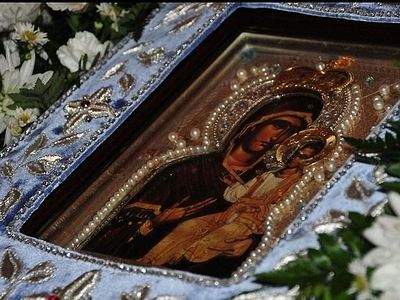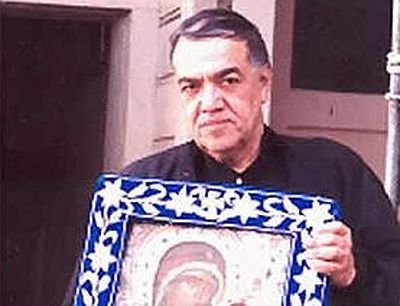Today we commemorate one of the copies of the Iveron Mother of God Icon, called the Montreal Iveron Icon, a miraculously myrrh-streaming icon from which abundant grace poured forth to the Russian diaspora and many other Orthodox Christians. As God’s Providence and the Mother of God would have it, the man who was found worthy to receive this icon from Mount Athos and become its custodian was in fact a convert to Orthodoxy from Catholicsim—José Muñoz from Chile, now also known as “Brother José.” Archpriest Victor Potapov spoke with the icon’s custodian on one of his visits to Washington.
* * *
The Iveron Icon, which at present is preserved in a monastery on Mount Athos, was according to tradition painted by the Apostle and Evangelist Luke. In November 1982, a copy of the Iveron Icon of the Mother God began to stream myrrh in Canada. In 1983, the Icon was in Washington for the first time, and I then asked its guardian, the Spaniard José Muñoz, how he had received the Holy Object, and when it had begun to stream myrrh. Here are his own words, which were recorded during our conversation with him:
“Once during our pilgrimage on Athos, after several hours of walking, we got lost. It began to get dark. We needed quickly to find shelter for the night. Going along a path, we stumbled upon a small, poor skete. There the fourteen Greek monks of the skete were engaged in iconography. They received us very cordially. Having rested a little, we began to examine the icons of their work. One of my fellow travellers, who spoke Greek, got into a conversation with the monks and told them who we were and where we were from. I, though, taking advantage of the moment, began more attentively to examine everything round about. Suddenly my gaze stopped at an icon of marvelous artistry with dimensions of approximately fifteen by twenty inches. I asked a monk if he could not sell it to me. He refused, having explained that this image was the first to be painted in that skete and therefore could not be sold. I could not tear my eyes from that wondrous icon. We stayed the whole night in the skete and in the morning stood through the Liturgy. During the singing of “It is truly meet”, I begged the Queen of Heaven on my knees to let the Holy Image go with me... Bidding farewell in the morning, all the monks accompanied us, but the hegoumen [abbot.—O.C.] was not among them. And then at the last minute before our departure from the monastery we saw him: he quickly descended the staircase with the wrapped-up icon in his hands. He came up to me and said, “Take it. I am gifting it to you. It must be with you.” I offered to pay for the icon, knowing that the monks were needy; but the hegoumen said severely, “One must not take money for such a holy object!” I crossed myself, kissed the image and made a vow to myself that that image would never become the source of my enrichment...
“After this, we set out at once for Iveron Monastery in order to receive the superior’s blessing and to touch the icon received by me to the original, which is preserved in this famed monastery. But by far not everyone is allowed to approach and touch the ancient wonderworking icon. Glory be to God, we were permitted! In the chapel, we knelt, and gazing at the holy object, froze in prayer before the image of the Iveron Mother of God. The image was so majestic, so shiningly beautiful, and radiated such spiritual power that it was difficult to gaze at it for long! A hieromonk helped me touch my copy to the Original.
“Soon after this we went home to Canada. We returned on November 3, 1982. I put the icon next to the relics of the saints of the Kiev Caves Lavra and the New-martyr Elizabeth Feodorovna, which I had received from the reposed Archbishop Leonty of Chile. A lampada flickered before it all the time, and each day before sleep I read Akathists to it. On the 24th of November, I was awakened at three o’clock in the morning by the powerful aroma of roses—the whole room was filled with it. At first I thought that it emanated from the relics or from a spilt vial of perfume; but upon approaching the icon, I was struck! The whole icon was covered with oil—a fragrant oil! I froze on the spot at such a miracle!”
Consolation of the faithful
Upon the advice of a local Orthodox clergyman, the Icon was taken to church and placed on the altar. During the entire liturgy, myrrh flowed from the hands of the Christ Child. Since that time, with the exception of several days during Holy Week, when the Icon is absolutely dry, the myrrh has continued to flow almost uninterruptedly. (Holy Myrrh is a sweet, fragrant oil which was used in the Old Testament for the anointing of kings. In contemporary Orthodox church practice, a newly born Christian is anointed with Holy Myrrh during which the words “The seal of the gift of the Holy Spirit” are said by the priest.)
In the years since, Jose traveled to many cities and parishes where the Icon was venerated to the great joy and consolation of the faithful.
Wherever the Icon went, there are always many questions. Some people initially had doubts. A scientist in Miami was astounded to see that the back of the Icon remained perfectly dry. He later surreptitiously chipped off a small piece of the board on which the Icon is painted for scientific analysis: it was found to be ordinary pinewood, nothing more.
At some times the myrrh would flow in greater abundance than at others. During the consecration of a bishop in Montreal there was such an outpouring of the myrrh that it streamed down from the analogion (lectern on which icons are kept in Orthodox churches) onto the floor. On another occasion, in Florida, the myrrh was seen to rise forth from the hands of the Mother of God and the Christ Child as though it were being pressed from within. Nobody had any power to regulate the flow of the myrrh, it would move at the will of God and His Most Pure Mother.
The Icon was kept in a frame about two inches deep and measures about 12 by 18 inches. At first the myrrh flowed only from the hands of the Mother of God, from the star on Her left shoulder and, occasionally, from the hands of Our Lord Jesus Christ. Yet in March 1985, during a Lenten service, even the frame and glass of the Icon began to exude myrrh in such quantities, that the cloth of the analogion on which it lay was totally saturated. There was always a layer of cotton wool placed at the base of the Icon to absorb the myrrh: pieces of this cotton were distributed to the faithful.
Although there have already been several cases of physical healing (not only among Orthodox, but Catholics and Protestants, too), the purpose of the Mother of God seemed to be directed more at the healing of souls. Many who have stood before the Icon have testified to this, experiencing not only compunction and repentance, but consolation as well.
As mentioned earlier, the flow of myrrh would cease during Holy Week. It would cease on Holy Monday. After the Liturgy on the morning of Great Saturday, a light dew of myrrh would form on the Icon, its case and protecting glass. During Matins (the midnight service at which the glorious Resurrection of Our Lord is proclaimed), when the procession of clergy and faithful, holding icons and banners, would leave the church, the Icon would begin to exude myrrh in such quantities, that it would cover the hands of the person carrying it.
This is not the first time that the Orthodox Church has witnessed such a miracle. In the nineteenth century the Surety-of-Sinners Icon in Moscow exuded myrrh with which the sick were anointed and received healing. Earlier, there was a myrrh-streaming icon of the Mother of God in the Tolga monastery in Yaroslavl; and there have been others.
What is the meaning of this extraordinary manifestation of God’s grace in our time? It has been observed that in the history of the Church such miracles have occurred in times of great tribulation; we saw this in the Apostolic times, and, more recently, in Russia, where the Church suffered cruel persecution for 70 years. The miracles strengthen the faithful and prepare them to endure trials. The appearance of the myrrh-streaming Icon in our time may well signify a period of further great trials for the Russian Orthodox Church and, at the same time, offer consolation that the Mother of God will be a Protectress of the faithful: Unto whomsoever much is given, of him shall much be required.
The death of Brother Jose and the loss of the icon
José Muñoz lived a monastic life, and some say he was secretly tonsured. He spent his entire life after the miraculous manifestation of the icon taking it to different parishes the world over for veneration by the faithful, and when he was at home he prayed continuously before it, commemorating names sent by people requesting prayers. But such an angelic man soon became ripe for the Kingdom of Heaven, and on October 31, 1997 he died a martyric death. In a hotel in Athens, where he was staying before returning home from a grace-filled pilgrimage to the holy places of Greece, this servant of God and His Most Pure Mother was brutally tortured and murdered by unknown Romanian criminals. Although he had not taken the Icon with him to Greece, the whereabouts of the miraculous, myrrh-streaming Icon are still unknown.
However the Mother of God did not leave her children without this consolation, and just before the tenth anniversary of Brother Jose’s death, a printed paper copy of the Montreal icon began streaming myrrh in Hawaii. Now this icon is taken to parishes, bringing consolation and reconciliation.
Holy Brother José, remember us also in your prayers where you abide in the Heavenly Kingdom!
Adapted from an article on the website of St. John the Baptist Cathedral, Washington, DC
